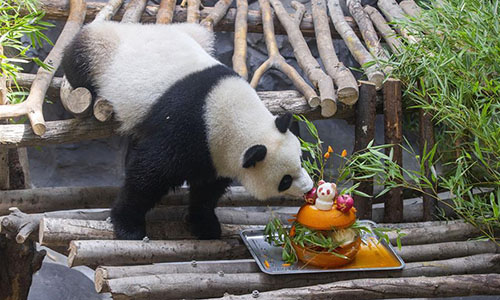Captive pandas reach 548, a record high

Two capitive pandas strike a cut pose from a tree in their habitat in Southwest China's Sichuan Province. (Photo/Courtesy of the Chengdu Research Base of Giant Panda Breeding)
Survival rate of cubs triples in 30 years, hits 93 percent
The number of giant pandas living in captivity has reached 548, a record high, and the survival rate of panda cubs born in captivity reached 93 percent this year, an official at the State Forestry and Grassland Administrations (SFGA) said on Thursday.
After decades of caring for giant pandas, China's panda experts have all but perfected creating sound conditions to raise and breed giant pandas, according to a press release the SFGA sent to the Global Times on Thursday.
The release said that 45 of 48 panda cubs born in captivity this year survived.
In the 1990s, the survival rate of captive-born cubs was only 30 percent, according to information on the website of the Chengdu Research Base of Giant Panda Breeding.

Forty-three of this year's surviving newborn giant pandas were born in China; one was born in Japan and the other in Malaysia.
Li Chunliang, vice administrator of the SFGA, told a conference held in Chengdu, capital of Southwest China's Sichuan Province on Thursday that scientists are looking to expand the genetic diversity in their breeding pairs of pandas by avoiding mating pandas that share blood ties, according to the SFGA press release.
Li said that China will continue releasing captive-born pandas into the wild after they receive extensive trainings enabling them to adapt to living on their own in the wild. Nine captive-born pandas have been released into the wild since 2003, and another will be released this year, said Li.
In 2016, a giant panda named He Sheng was found dead two months after it had been released into the wild. It had been attacked by "unknown animals," said the Chengdu Research Base of Giant Panda Breeding at the time. Media reported four of the released-to-the-wild pandas have not survived.
The incidents sparked heated discussions, with netizens worried the giant pandas could not survive after being released into the wild.
"Pandas are not pets. Their real home is in the wild. They may face various threats in the wild, they will adapt and live better there. Keeping them captive forever is not our purpose," Zhang Hemin, deputy director of the Chengdu-based China Conservation and Research Center for the Giant Panda, said in the SFGA press release.
Another purpose for releasing pandas into the wild is to see if they can successfully mate on their own, Zhang explained.
In August 2017, female giant panda Cao Cao gave birth at the Hetaoping semi-wild training base in Sichuan Province. She became pregnant after being released into the wild, the Xinhua News Agency reported.
China is also working with 22 zoos and safaris from 17 countries to better protect pandas, said Li, noting that China has sent 58 pandas to other countries to help local scientists to conduct research and bring joy to local people.

National treasury
Li also said they are speeding up the creation of the Giant Panda National Park to better protect panda habitat.
During the Thursday conference, Tang Xiaoping, deputy head of the National Park Administration, said work on the national park has begun and a pilot project is underway.
According to the plan, the 27,134-square-kilometer park will cover areas in Sichuan and Northwest China's Gansu and Shaanxi provinces. Li said the park will impose strict regulations to protect and improve the natural ecology of the vast area.
Facilities and factories that will not protect the park will be relocated from the park area. Also, human activity will be strictly limited within the area, according to another news release the SFGA sent to the Global Times on Thursday.
The park will consist of a core area that will include 67 reserves for many of the 1,864 wild-born giant pandas and 8,000 wild animals and plants, Xinhua reported in March, 2017.
